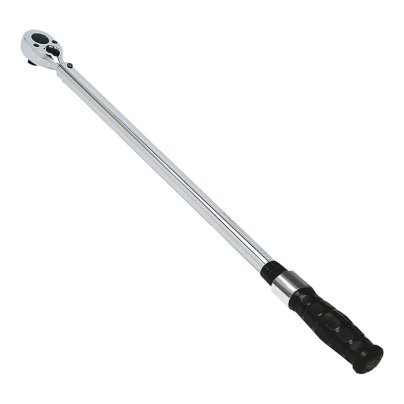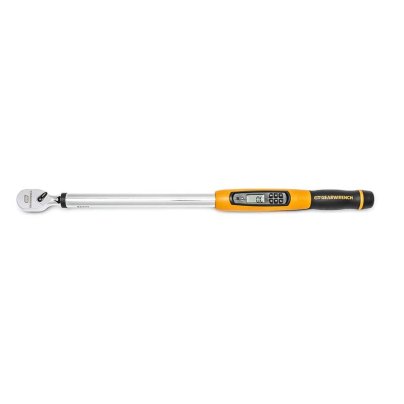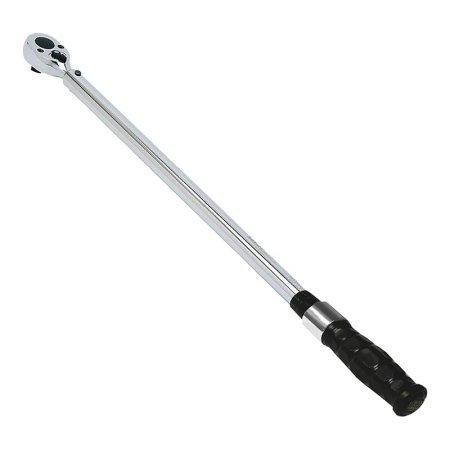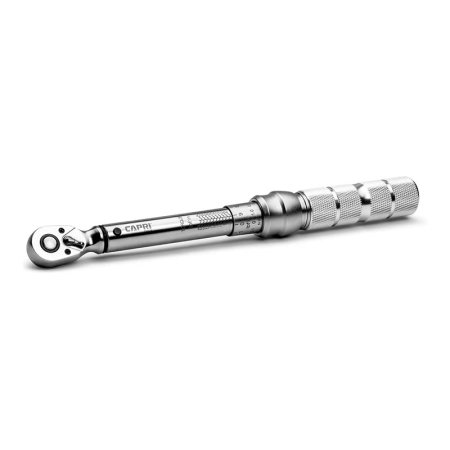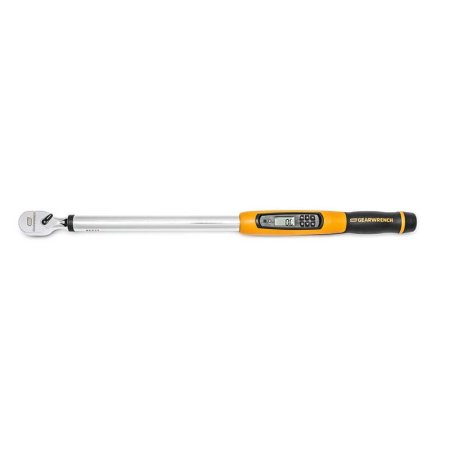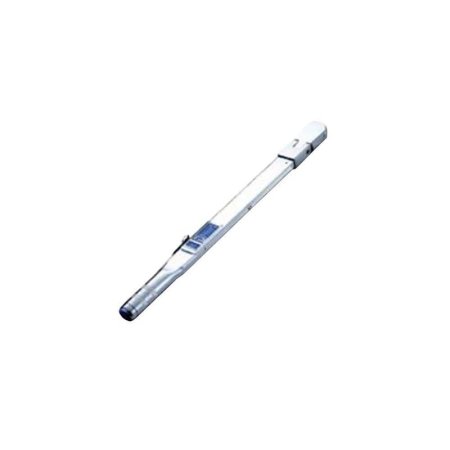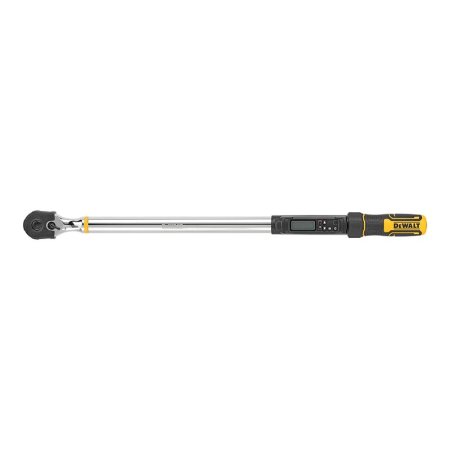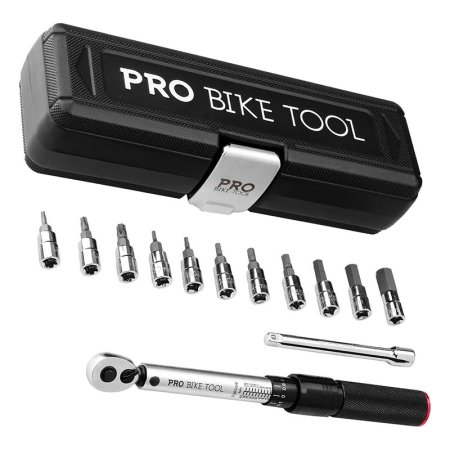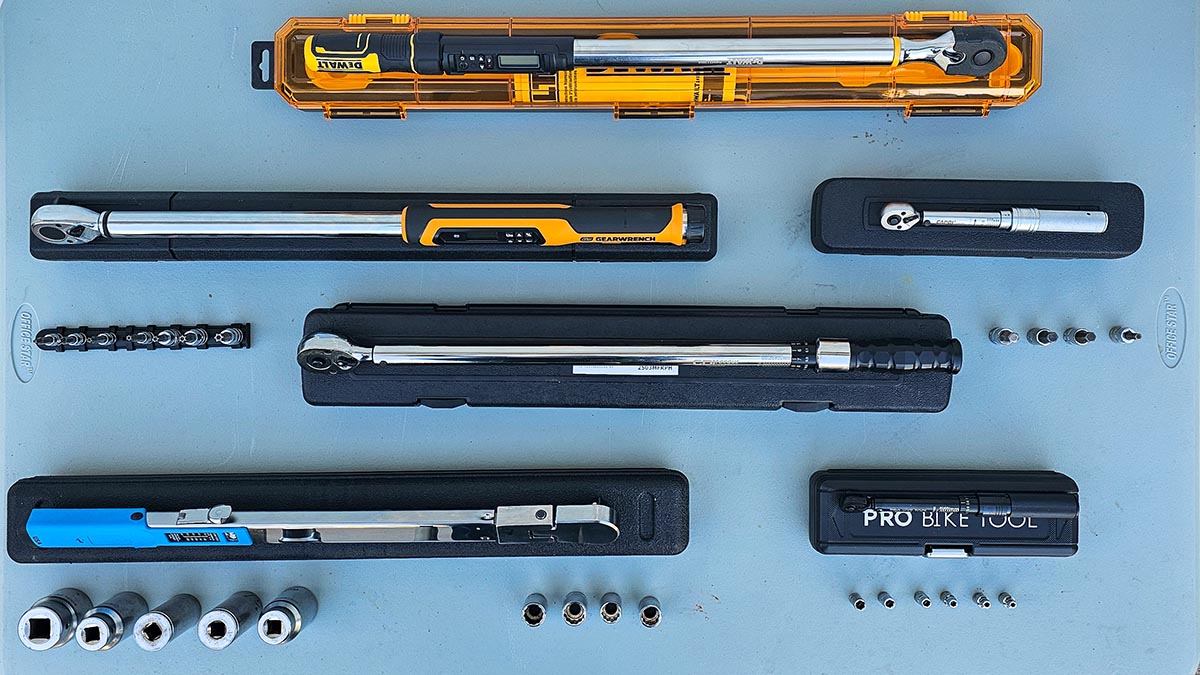
We may earn revenue from the products available on this page and participate in affiliate programs. Learn More ›
Torque wrenches are designed to help users tighten fasteners with a level of precision vital for matching a manufacturer’s torque specs. We tested several highly rated types of torque wrenches on nuts and bolts in our own garages, and we found a favorite: the CDI Torque Products ½” 30-250 ft-lbs Torque Wrench, which stood out for its ease of use and comprehensive torque pressure range.
We tried out a variety of torque wrenches, from small ones made for bicycles to large ones capable of tightening heavy-duty fasteners on construction equipment. Keep reading to learn what to consider when applying precise torque to a specific fastener, and find out how the following tools earned a spot on this lineup of the best torque wrenches.
- BEST OVERALL: CDI Torque Products ½” 30-250 ft-lbs Torque Wrench
↓ Jump to Review - BEST BANG FOR THE BUCK: Capri Tools ¼” 30-150 ft-lbs Industrial Torque Wrench
↓ Jump to Review - BEST HIGH-TECH: Gearwrench ½” 25-250 ft-lbs Electronic Torque Wrench
↓ Jump to Review - BEST SPLIT-BEAM: Precision Instruments ½” Split-Beam Click Wrench
↓ Jump to Review - BEST DIGITAL: DeWalt ½” 50-250 ft-lbs Digital Torque Wrench
↓ Jump to Review - BEST FOR BIKES: Pro Bike Tool ¼” 2-20 Nm Torque Wrench Set
↓ Jump to Review
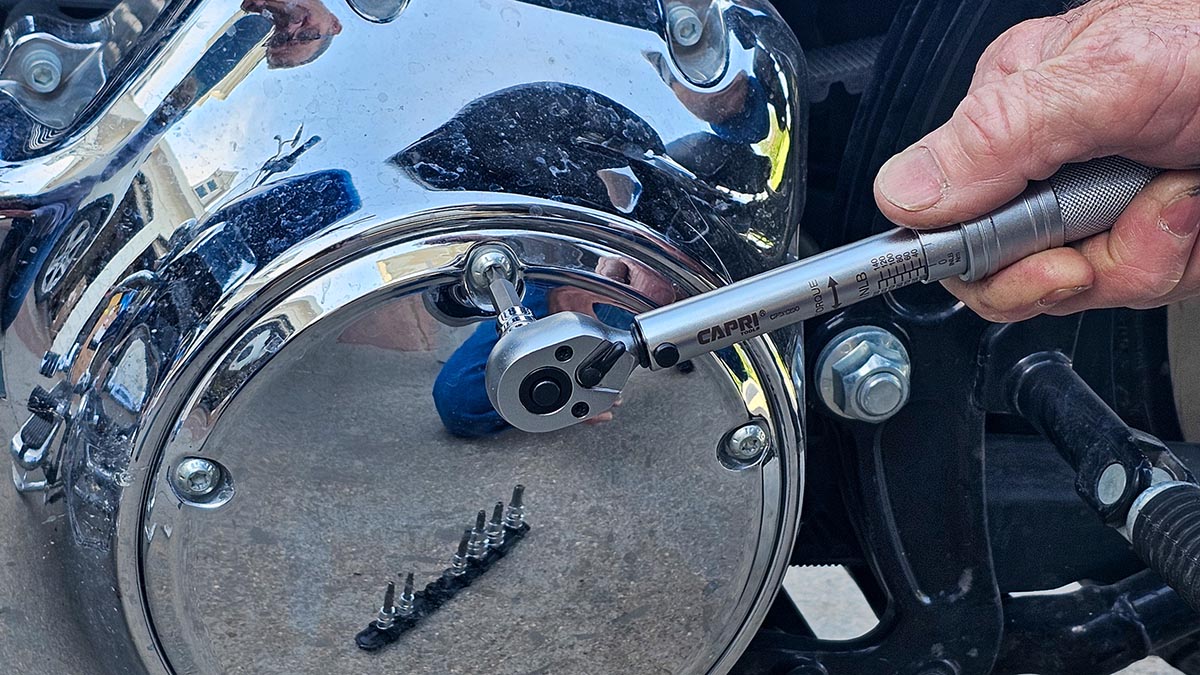
How We Tested the Best Torque Wrenches
Determining which torque wrenches we wanted to test was straightforward. We considered the brand to an extent—after all, DeWalt, Precision Instruments, and CDI (now owned by Snap-on) are highly respected for their DIY and professional tools. We also considered some Stanley sets, but in the end, we didn’t test any. We focused on choosing a diverse range of torque wrenches that would suit a variety of users and budgets.
In our hands-on tests, we tightened nuts and other fasteners on car tires, engine components, motorcycles, bicycles, and heavy equipment. We used two methods to check accuracy: First, we used a simple torque adapter, a gauged tool that attaches to a wrench or socket to measure torque pressure. (In general, torque adapters are not as accurate as calibrated torque wrenches, but they offer a basic reading.) We then compared two different torque wrenches set to the exact desired torque setting to see if both wrenches produced matching results on the same fastener.
We also noted each tool’s build quality, ergonomics, and ease of selecting the correct torque. We awarded points based on a rubric, and after testing, we averaged the points to determine our best overall pick and to categorize the other models in our lineup of the best torque wrenches.
| Testing Stats | |
| Products tested | 6 |
| Hours spent testing | 6 |
| Tests performed | 3 |
| Price range | $54 to $230 |





Our Top Picks
The following torque wrenches are made for different purposes. Some are compact and easy to tuck into a bicycle bag, while others are quite large and better suited to changing truck tires or for use as an automotive torque wrench. Torque wrenches come in a range of sizes and price points, and we suspect at least one of the following could be a good match for your needs.
Best Overall
CDI Torque Products ½" 30-250 ft-lbs Torque Wrench
Product Specs
- Type: Micrometer
- Accuracy: ±4 percent CW, ±6 percent CCW
- Drive size: ½ inch
- Torque range: 30 to 250 foot-pounds
Our Ratings: Ease of Use 4.5/5; Accuracy 5/5; Build Quality 4.5/5; Value 4.8/5
What We Like
- Ratcheting head for easy use
- Measures torque clockwise and counterclockwise
- Figures torque in foot-pounds and Newton meters
What We Don’t Like
- Handle’s grip is a bit small
- High-torque applications require physical strength
If you’re looking for a good mechanical torque wrench with a high range of torque settings, check out CDI’s ½-inch torque wrench. It boasts an impressive 30- to 250-foot-pound range, and we liked that it figures torque in both foot-pounds and Newton meters.
The CDI wrench passed our accuracy tests—both the comparative test and with the torque adapter—but that’s not unusual. Torque wrenches typically arrive highly calibrated and remain calibrated unless damaged or misused.
We used the CDI wrench to tighten lug nuts, suspension system fasteners (struts), and some structural steel bolts on a skid steer bucket. We adjusted the torque pressure for the first two using the foot-pound increments on the tool. The structural bolts called for pressure in Newton meters (Nm), so we turned the tool over and used the Nm scale to select the pressure.
The ratcheting head is a nice feature. It ratchets in both directions, but we felt as though the grip was slightly undersized given the wrench’s high-pressure range. Someone with large hands might not be able to get a firm enough grip when using the wrench at high-torque settings, as this requires a substantial amount of physical force.
This quality torque wrench has an accuracy rating of ±4 percent, making it a good pick for tightening low- and high-torque fasteners.
Get the CDI torque wrench at Amazon.
Best Bang for the Buck
Capri Tools ¼" 30-150 in-lbs Industrial Torque Wrench
Product Specs
- Type: Micrometer-style click
- Accuracy: ±4 percent CW/CCW
- Drive size: ¼ inch
- Torque range: 30 to 150 inch-pounds
Our Ratings: Ease of Use 4/5; Accuracy 5/5; Build Quality 4.8/5; Value 5/5
What We Like
- Affordable price for quality torque wrench
- Accurate for low-torque fastener applications
- Lightweight and compact at 1.35 pounds
- Comes with heavy-duty hard case for protection
What We Don’t Like
- Does not measure in foot-pounds (inch-pounds only)
- Not suitable for high-torque applications
You don’t have to spend a fortune to get a good torque wrench for tightening fasteners. Capri Tools offers this small torque wrench at an affordable price. We tested this wrench on various low-torque fasteners, including oil pan bolts, small appliance fasteners, and some HVAC unit screws.
This ¼-inch drive compact torque wrench weighs only 1.35 pounds and measures just over 8 inches long. Adjusting the desired torque setting was simple: As with most micrometer wrenches, we just rotated the collar to set the torque. The numbers on the handle are clear and easy to see, and the tool is balanced, so it feels good in the hand. It offers smooth ratcheting action, as well.
The Capri was spot on in our accuracy tests, and we were impressed with its performance. The wrench features excellent build quality considering its budget-friendly price, and we wouldn’t hesitate to recommend it to professionals who need a durable lower-torque tool. The heavy-duty hard case it comes in is a great way to store and transport the tool safely.
Get the Capri Tools torque wrench at Amazon.
Best High-Tech
Gearwrench ½" 25-250 ft-lbs Electronic Torque Wrench
Product Specs
- Type: Digital
- Accuracy: ±2 percent CW, ±3 percent CCW
- Drive size: ½ inch
- Torque range: 25 to 250 foot-pounds
Our Ratings: Ease of Use 4.3/5; Accuracy 5/5; Build Quality 4.5/5; Value 4/5
What We Like
- Vibrating handle plus LED indicator
- Measures torque in clockwise and counterclockwise directions
- Easy-to-use button controls and an ergonomic handle
What We Don’t Like
- Beeping indicator wasn’t as loud as expected
As you approach the desired torque setting, Gearwrench’s electronic torque wrench warns you with its vibrating handle, beeping sound, and a solid LED light indicator so that you can stop before you overtighten the fastener. We loved the vibration and the LED indicator, but the beeping sound was on the quiet side—half the time, we didn’t hear it at all.
This digital wrench can measure torque in both clockwise and counterclockwise directions. We tested it on lug nuts and structural bolts. The ergonomic handle allowed us to get a good grip when tightening high-torque fasteners, but we found it a little unwieldy in tight spaces.
The wrench’s digital display replaces the traditional scale, and we were able to set the torque level using the buttons on the handle. The Gearwrench has an impressive torque range of 25 to 250 foot-pounds, and it performed well in our accuracy tests. It comes with a heavy-duty storage case. On the downside, it doesn’t come with the two required AAA batteries, so plan to buy them separately.
Get the Gearwrench torque wrench at Amazon or The Home Depot.
Best Split-Beam
Precision Instruments ½" Split-Beam Click Wrench
Product Specs
- Type: Split-beam
- Accuracy: ±4 percent CW
- Drive size: ½ inch
- Torque range: 40 to 250 foot-pounds
Our Ratings: Ease of Use 5/5; Accuracy 5/5; Build Quality 4.5/5; Value 4/5
What We Like
- Durable; built for long-term use
- Angle head eases access to tight areas
- Clear, easy-to-read settings gauge
What We Don’t Like
- Rectangular grip is less comfortable than round grip
Split-beam torque wrenches are known for consistent accuracy, durability, and less frequent calibration requirements. In our hands-on tests, the Precision Instruments’ ½-inch split-beam wrench passed with flying colors in several areas. It excelled in our accuracy tests, and we were impressed with its build quality.
We adjusted the torque settings via a secure dial on the front of the handle. The foot-pound numerals are black on a white background, and we had no trouble seeing how much torque we were applying. A flip-down guard keeps the dial from being accidentally changed to a different setting during use.
This ½-inch drive angle torque wrench has a nonslip grip and a tilt head, which makes it easier to access fasteners in confined areas. We tested this professional torque wrench on car and truck lug nuts and industrial fasteners on construction equipment. The only thing we didn’t care for was the rectangular shape of the grip, which is not quite as comfortable as a round grip.
Get the Precision Instruments torque wrench at The Home Depot.
Best Digital
DeWalt ½" 50-250 ft-lbs Digital Torque Wrench
Product Specs
- Type: Digital
- Accuracy: Not listed
- Drive size: ½ inch
- Torque range: 50 to 250 foot-pounds
Our Ratings: Ease of Use 4.5/5; Accuracy 4.8/5; Build Quality 4.5/5; Value 4.8/5
What We Like
- Measures torque in foot-pounds, inch-pounds, and Newton meters
- Clear, easy-to-see digital readout
- Ergonomic nonslip handle for firm gripping
What We Don’t Like
- On the heavy side at 5.64 pounds
- Small buttons may be hard to use with gloved hands
This torque wrench is highly versatile because it can measure torque in foot-pounds, inch-pounds, and Newton meters. The DeWalt ½-inch drive torque wrench has a nice digital readout that we were able to see clearly, even in sunlight. Torque pressure was easy to select with up/down buttons, but the buttons are a bit on the small side, which could pose a problem for someone using the tool while wearing gloves.
The tool’s torque range is 50 to 250 foot-pounds, and it’s a big boy. It weighs 5.64 pounds and measures 28.8 inches long, making it the largest wrench we tested. We really liked the ergonomic nonslip handle, as it allowed us to get a firm grip, which is vital when tightening high-torque fasteners. We tested it on car and truck lug nuts and heavy-duty fasteners on construction equipment.
Like most DeWalt tools, the build quality is good, but at this length, we found ourselves wishing the tool was a digital angle torque wrench to make it simpler to access fasteners in tight spots. It comes with a nice case with a dense foam cutout to protect the tool in case it’s dropped. While DeWalt doesn’t list the wrench’s accuracy range, it easily passed our accuracy tests.
Get the DeWalt torque wrench at Amazon or The Home Depot.
Best for Bikes
Pro Bike Tool ¼" 2-20 Nm Torque Wrench Set
Product Specs
- Type: Click
- Accuracy: ±4 percent CW, ±6 percent CCW
- Drive size: ¼ inch
- Torque range: 2 to 20 Nm
Our Ratings: Ease of Use 4.5/5; Accuracy 5/5; Build Quality 4.8/5; Value 5/5
What We Like
- Includes 11 sockets for versatility
- Suitable for bikes and other small fasteners
- Metric measurements meet most bike specifications
What We Don’t Like
- Lacks a nonslip grip
- Not for use with high-torque fasteners
If you’re looking for a metric torque wrench for bicycle maintenance and repair, look no further than the Pro Bike Tool ¼-inch torque wrench set. It comes with an assortment of 11 sockets (hexagon and Torx) and a rugged case for storing them all.
We tested this torque wrench on our bikes to tighten seat-post clamp bolts, stem bolts, and pedal fasteners, but it’s more than just a bike tool. We also tested it for tightening fasteners on a lawn mower and our HVAC unit. With a range of 2 to 20 Nm, this low-torque wrench is perfect for smaller fasteners.
The Pro Bike wrench issued an audible click every time we reached the desired torque pressure for a fastener. It was very easy to use, and it passed our accuracy tests with flying colors. The case is small enough to slip into a bike bag for use on the road. It doesn’t feature inch-pounds, but many bike manufacturers use metric measurements for their fasteners, so that shouldn’t be a problem. We would have liked a nonslip grip, but overall, this set contains everything needed to make quick bike repairs.
Get the Pro Bike Tool torque wrench at Amazon.
Jump to Our Top Picks
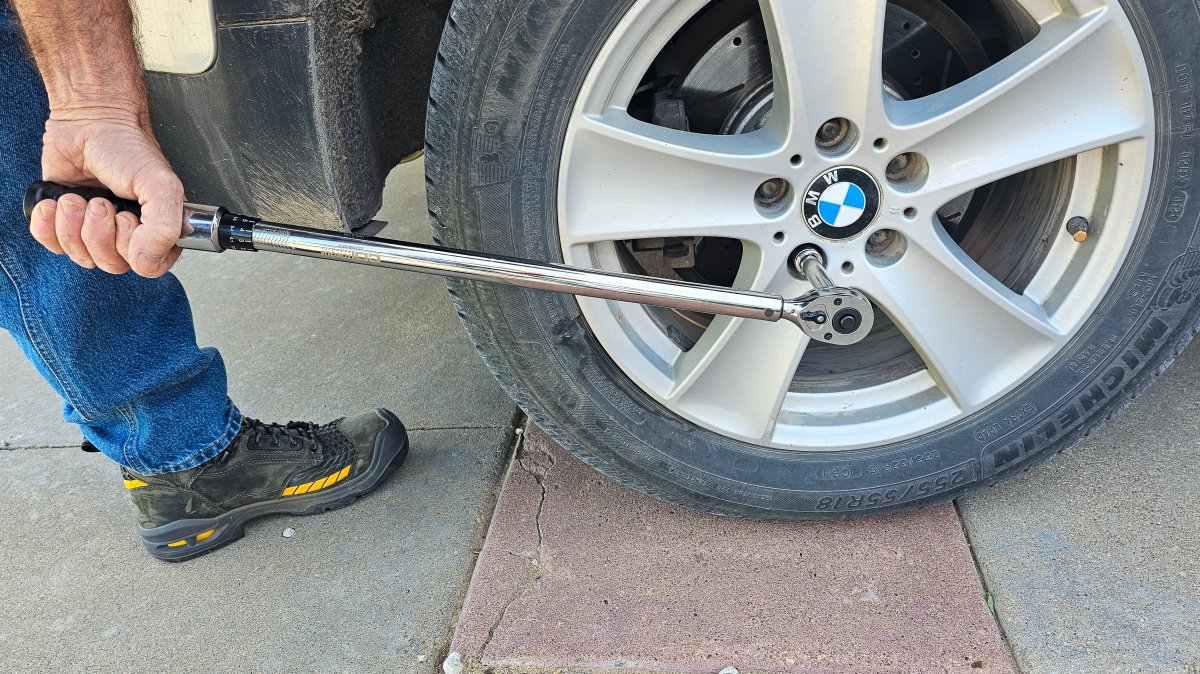
What to Consider When Choosing a Torque Wrench
Before buying a torque wrench to add to your home tool kit, consider these important product characteristics and how they apply to the torque wrench you want.
Accuracy
Accuracy is always an important consideration when it comes to a torque wrench. Fortunately, torque wrenches come precalibrated and are often accompanied by a certification card that confirms that the wrench was tested immediately before packing.
Typically (though not always), a torque wrench manufacturer will state the tool’s measured accuracy based on the calibration test. This calibration level generally has a ±4 percent accuracy rating, so if you find a wrench with a smaller accuracy range (e.g., ±3 percent accuracy), you know you have a superior product.
Some of the newer torque wrenches are bidirectional, which can tighten right-threaded or left-threaded fasteners. However, they are not designed to loosen fasteners, and using them to loosen fasteners can result in damage or the need to have the tool professionally recalibrated. If the wrench is bidirectional (some we tested were), accuracy will be listed as something like “±3 CW, ±4 CCW.”
Drive Size
The torque wrench’s drive size describes the bits you can use to tighten nuts and other fasteners. The standard sizes include ¼ inch, ⅜ inch, ½ inch, ¾ inch, and 1 inch, though you won’t be working with anything above a ½-inch drive for most applications.
- A ¼-inch drive is the smallest of the common drive sizes and is frequently used for motorcycles, mopeds, lawn mowers, and even some HVAC applications. They are also used to tighten tiny automotive fasteners.
- A ⅜-inch drive typically assists in major automotive repair for engine work, including tightening spark plugs. However, the ½-inch drive is good for working on spark plugs with the correct bit. The ⅜-inch drive is the second most common drive size used.
- A ½-inch drive is the most common size. Use this option to install lug nuts on vehicle wheels and tighten fasteners on your vehicle’s suspension.
- You only use a ¾-inch or 1-inch drive when working with massive vehicles, like a semitruck or a large construction vehicle. This size typically pairs with a long breaker bar to help deal with tough truck lug nuts.
Range
The range of a torque wrench can limit the types of jobs it can accommodate, so how much torque a wrench provides is very important. On average, a torque wrench with a range that falls below 80 foot-pounds may be ineffective for some car torque wrench applications. However, a lower torque range is ideal for smaller tasks, like working on a lawn mower or bicycle.
Many torque wrenches have a range that spans up to 150 foot-pounds, which is more than enough to tighten lug nuts on your car. However, some torque wrenches have a much wider torque range, with some reaching 1,000 foot-pounds of force. Unfortunately, tightening high-torque fasteners requires physical strength and sometimes the use of torque multipliers for added leverage.
Scale Readability
Before picking up a new torque wrench, be sure to select a type with a scale that you are comfortable reading so that you do not constantly struggle to discern the current torque level.
- Beam torque wrenches, including standard, deflecting beam, and split beam, have a simple scale located on the wrench handle to indicate the torque amount.
- Slip-style torque wrenches do not have a scale or gauge to keep track of the current torque level, so they’re not typically used in the automotive industry.
- Click-style torque wrenches, including interchangeable head and micrometer click torque wrenches, use a scale on the body’s handle. This scale is frequently engraved into the metal for an easily readable result.
- Digital torque wrenches come precalibrated for precise readings that are displayed on the digital screen. This style of torque wrench offers the most precise readings in the most straightforward format, but the wrench won’t work if the batteries run out of juice.
Ratcheting
Most torque wrenches offer ratcheting. The ratcheting head offers convenience and speed when tightening fasteners because the user can apply torque continuously without the need to reposition the wrench.
Storage
Even the best torque wrench can require recalibration if not used correctly or subjected to impact, such as being dropped on the ground or knocked against other tools.
Due to this sensitivity, it is a good idea to find a product with a box or another protective storage container that can keep your torque wrench safe from the other tools in your workshop and any incidental contact. You may also want to find a torque wrench storage container with interior padding and a lockable clasp for additional protection and security.
Grip
When shopping for a new torque wrench, it is important to consider the handle’s grip. Due to the torque wrench’s sensitivity, look for a handle you can grip without slipping so that you can quickly stop the motion of the wrench handle when you reach the desired level of torque—this will help prevent overtightening.
You will also want a comfortable, ergonomic handle to help you work longer without worrying about hand fatigue. Most torque wrenches come with a rubberized plastic handle or a steel handle with a raised grip. Go with the rubber grip for heightened comfort or the metal grip for additional friction and control.
Types of Torque Wrenches
There are many types of torque wrenches, each offering unique features to be aware of before choosing a new tool. Torque wrench types include beam, deflecting beam, split-beam, slip, click, digital, interchangeable head, and micrometer.
Beam
A regular beam torque wrench doesn’t rely on anything except the flex of an internal beam to measure the degree of torque being exerted on the nut. This wrench style indicates the amount of torque (twisting force) being applied. This measurement is taken when you apply force to tighten a fastener; the beam flexes just slightly, and a pointer moves along a scale to measure the pressure you’re applying. Wrenches of this type are typically inexpensive and do not require frequent calibration or maintenance.
Deflecting Beam
A deflecting beam torque wrench uses a principle similar to that of a regular beam torque wrench, except a deflecting beam wrench has a more sophisticated mechanism that indicates torque without using a separate needle as a regular beam does. While the two types are similar, as both flex or “deflect,” the regular beam type uses a needle that moves along a scale to measure torque, while a deflecting wrench measures the actual degree of flex (deflection) of the tool’s internal beam. Deflecting torque wrenches are typically more expensive and considered more accurate.
Split Beam
The split-beam torque wrench looks and functions like a deflecting beam wrench. It uses two beams: The second beam runs alongside the first and indicates the torque pressure on a dial located on the handle.
With this torque wrench style, you can usually set the torque limit, so you won’t have to worry about overtightening. It may also utilize a “click” sound (as with click-style torque wrenches) to indicate when you have reached the desired torque level. However, that feature is not standard for all split-beam torque wrenches.
Slip
A slip-style torque wrench is one of the least popular designs for professionals in the automotive industry. It does not have a scale or gauge, so you cannot monitor the torque exerted with this type of wrench. You may have a hard time finding a heavy-duty version of a slip wrench that produces the same level of torque as a regular click torque wrench.
On the upside, a slip torque wrench reduces the risk of overtightening because the drive disengages when the desired torque is reached. Still, it typically has a limited torque range, making it unsuitable for many applications.
Click
Click-style torque wrenches are the most popular type. This style of wrench can be set to a specific torque level by twisting the base of the handle to match up with the desired setting on the handle. It’s affordable and accurate, though not as durable as a beam torque wrench.
A click torque wrench gets its name from the audible click the wrench emits when it reaches the desired torque level. However, the click is only an indicator, and most click-style torque wrenches do not prevent overtightening the fasteners.
Digital
Digital torque wrenches are typically the most expensive options. They come precalibrated with precise readings displayed on a digital screen. When the desired torque level is reached, a digital wrench will typically notify you with a buzz, beep, vibration, light, or some combination of these alarms to prevent you from overtightening the fastener. However, this type of electric torque wrench requires batteries, and you may need to return it to zero before storing it to prevent it from needing calibration.
Interchangeable Head
The interchangeable-head torque wrench is not a completely different type of wrench. This click-style torque wrench accommodates various heads so that you can complete various tasks with an assortment of fasteners and fastener sizes. Like the regular click torque wrench, this style of wrench also emits a loud click sound to indicate when it has reached a set torque level.
Micrometer
Micrometers are another subclass of the click torque wrench. They operate like regular click torque wrenches but have both forward and reverse capabilities. This style also commonly comes with a quick-release trigger that allows you to set, adjust, and read the torque wrench without difficulty. Due to the extra features, the micrometer torque wrench is more expensive than a standard click torque wrench.
Tips for Using a Torque Wrench
A torque wrench is a specialized tool used for one main purpose: tightening fasteners like nuts and bolts. Care should be taken when using a torque wrench to avoid hard impacts, like dropping it on the ground. Even when it is in storage, dropping it on the ground can result in having to recalibrate the tool.
Before storing a torque wrench, adjust it to its lowest pressure setting. This helps keep the device adequately calibrated when it is not in use and keeps it working longer.
- Torque wrenches are specialty tightening tools that should only be used for their specified purpose.
- Be gentle when you are using and handling your torque wrench to maintain the proper calibration.
- When using certain torque wrenches, like click-type torque wrenches, always reset the torque wrench to the manufacturer’s recommended torque setting before putting the tool away in storage.
FAQs
Looking to expand your precision hand tool collection? Consider these helpful answers to a few of the most common questions about torque wrenches.
A torque wrench is a specialized tightening tool commonly used to tighten fasteners to the precise pressure level recommended by the fastener’s manufacturer. Torque wrenches achieve this by exerting rotational force on the fasteners. Most are sold as stand-alone tools, but some torque wrench sets are sold with suitable sockets.
You can use a torque wrench to tighten nuts but never to loosen them. If the wrench you are using is a type that needs the torque set, then set the torque using the physical dial on the handle or the digital keypad. Place the drive bit on the nut or bolt and tighten it until you reach the appropriate torque, which will be indicated differently for each type of torque wrench.
Torque wrenches are almost always calibrated by a professional who uses specialized equipment, such as a torque calibration machine, to ensure accuracy.
A foot-pound is a unit of measurement that represents the amount of rotational force applied to an object. The measurement is defined as the force of 1 pound applied from a 1-foot distance from the fastener’s pivot point. All wrenches, including pipe wrenches and strap wrenches, exert rotational force.
Yes, you can. If you want to use a foot-pound torque wrench for inch-pounds, just multiply the wrench’s foot-pounds by 12 to convert it to inch-pounds.
Meet the Tester
Glenda Taylor is a product tester and writer specializing in the construction, remodeling, and real estate industries. She and her husband own a general contracting company, and Taylor is experienced in both residential and commercial building applications. She tests a wide range of power tools as well as other home improvement, household, and lawn-and-garden products.
Additional research provided by Timothy Dale.
